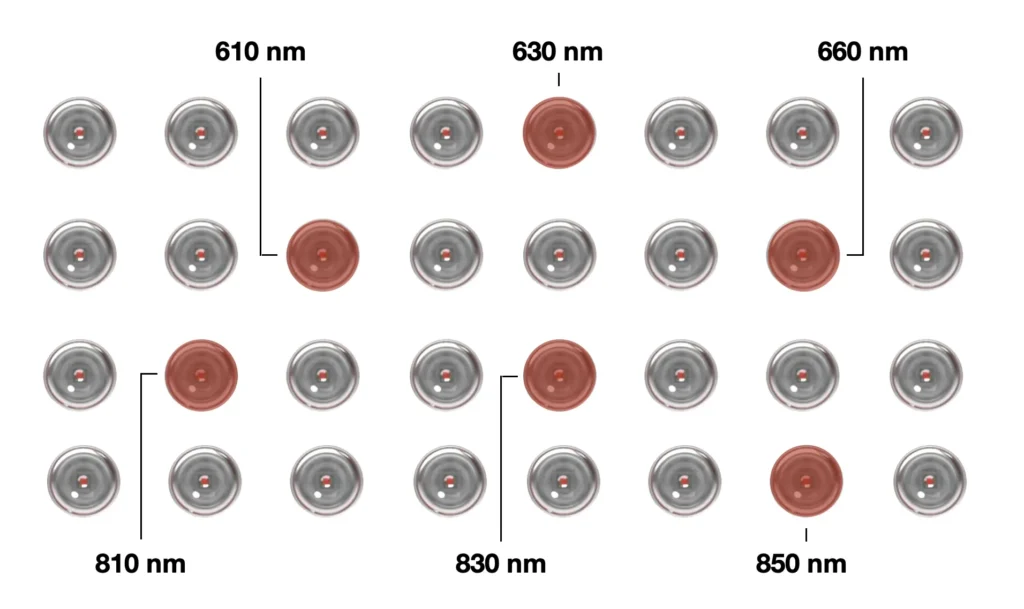1903
Niels Ryberg Finsen receives the Nobel Prize for pioneering phototherapy, demonstrating its effectiveness in treating lupus vulgaris, a type of tuberculous skin disease.
1917
Einstein’s groundbreaking theory lays the foundation for laser technology, influencing future advancements in light-based treatments.
1960
Theodore H. Maiman and his team develop the first working laser, marking a major milestone in optical science and medical applications.
1967
Hungarian physicist Endre Mester makes a surprising discovery—a low-powered laser that unexpectedly speeds up wound healing, paving the way for red light therapy.
1987
Commercial laser devices enter the market, advertised for pain relief, arthritis treatment, and tissue regeneration, despite limited scientific backing.
1989
Tiina Karu links red light therapy to mitochondrial function, sparking discussions on its biological effects beyond traditional laser applications.
1996
NASA confirms the benefits of red light therapy using LED technology, supporting its role in cell regeneration and healing.
2000+
Scientific research surges, with thousands of studies validating the effects of therapy on human biology.
2010
Technological advancements lead to more compact devices, offering broader coverage and enhanced usability.
Today
Ongoing research, continuous improvements, and integration of multiple wavelengths drive the next generation of red light therapy.

red and near-infrared light
Within the spectrum of light, red light (around 600-700nm) and Near-Infrared (NIR) light (approximately 700-1100nm) play pivotal roles.
Both work at a cellular level to promote healing, reduce inflammation, and enhance overall well-being. By penetrating different depths of the skin and tissues, these wavelengths trigger biological responses that support faster recovery, improved circulation, and optimized cellular function.
Recognizing the distinct impacts of these wavelengths is essential for maximizing their therapeutic benefits, underlining the significance of the wavelength spectrum in light therapy.
Clinically Proven Wavelenghts
To fully understand the benefits of multi-wavelength light therapy, it’s important to break down the specific roles of red light and near-infrared light. Each wavelength interacts with the body in unique ways, providing targeted benefits for skin health, cellular energy, muscle recovery, and inflammation reduction.

Red Light (600-700nm)
Red light therapy primarily targets the epidermis (outermost layer of the skin) and upper dermis. This wavelength is readily absorbed by skin cells, triggering a cascade of biological responses that enhance skin rejuvenation, wound healing, and cellular metabolism. This wavelength is optimal for addressing issues like fine lines, wrinkles, and promoting a vibrant skin appearance.

Near-Infrared Light (700-1100nm)
Near-infrared (NIR) light penetrates much deeper than red light, reaching muscles, joints, bones, and even nerves. Because NIR is invisible to the human eye, it works at a cellular level to enhance blood flow, reduce inflammation, and promote faster recovery from injuries and muscle fatigue.
Red and near infrared light have been proven in thousands of clinical studies to boost cellular health and performance.
Reverse Skin Aging Signs by Red Light Photobiomodulation. (2023)
Low-Level Laser (Light) Therapy (LLLT) in Skin: Stimulating, Healing, Restoring. (2013)
Mechanisms And Applications of the Anti-Inflammatory Effects of Photobiomodulation. (2017)
Photobiomodulation in Human Muscle Tissue: An Advantage in Sports Performance? (2016)
Proposed Mechanisms of Photobiomodulation or Low-Level Light Therapy. (2016)
Light Stimulation of Mitochondria Reduces Blood Glucose Levels. (2024)
Effects of Red Light on Sleep Inertia. (2019)
Unlocking the Power of Light on the Skin: A Comprehensive Review on Photobiomodulation. (2024)
Photobiomodulation in Bone Injury Repair: A Systematic Review. (2022)
Photobiomodulation: The Clinical Applications of Low-Level Light Therapy. (2023)
Biological Effects And Medical Applications of Infrared Radiation. (2017)
Explore the benefits
Explore the science-proven benefits of red and near-infrared light therapy for a healthier you.

Muscle Growth
Red light enhances circulation and surface-level muscle repair, while near-infrared penetrates deeper into tissues. This dual action reduces soreness, speeds up healing, and boosts muscle performance after workouts.

Skin & Hair
Red light stimulates collagen production, improving skin elasticity and reducing wrinkles. Near-infrared penetrates deeper layers, reducing inflammation, promoting cell repair, and supporting healthy hair growth.

Sleep
Red and near-infrared light help regulate circadian rhythms and reduce stress, promoting relaxation. Deeper penetration of near-infrared soothes chronic pain and inflammation, leading to more restorative sleep.

Hormonal System
Red light may help regulate skin-related hormones, while near-infrared reaches deeper into glands, supporting metabolic function and energy production. This combination may aid in balancing hormones naturally.

Eyesight
Red light supports eye hydration and circulation, relieving dry eyes and strain. Near-infrared may protect deeper eye structures, reducing inflammation and potentially preventing degenerative conditions over time.

Longevity
By boosting cellular regeneration, red light supports skin repair and tissue health, while near-infrared promotes deep healing within muscles and organs. This synergy may help delay aging and support overall wellness.

Bones
Red light aids in soft tissue recovery, reducing pain in muscles and joints. Near-infrared penetrates deeper, potentially accelerating bone repair, enhancing regeneration, and minimizing inflammation in injured areas.
Unlock Full-Spectrum Healing
Lumavit’s advanced multi-wavelength technology is designed to target specific cellular processes, ensuring comprehensive rejuvenation and deep tissue repair. By combining six distinct wavelengths—each scientifically validated—we provide a precise and effective approach to skin health, muscle recovery, and overall wellness.
With a spectrum ranging from the revitalizing red to the deeply penetrating near-infrared, experience a comprehensive light therapy session that is as multifaceted as the health benefits it delivers.

Red light and near-infrared light can be used to enhance the function of the cells.
Dr. Andrew Huberman
It has been shown that red light therapy can protect against hair loss, and improves skin.
Dr. David Sinclair
This therapy can be a game-changer for physical and mental health.
Dave Asprey
It’s proven that bodies and brains need light to function at their best.
Tony Robbins
I do red and near-infrared light therapy 3 times a week for each 12 minutes.
Bryan Johnson
Research highlights how red and near-infrared light therapy could help prevent dangerous blood clots by targeting key mechanisms in the body.
Dr. Mark Hyman
Lumavit combines innovation and quality in light therapy for exceptional results.
Our light therapy devices are crafted from high quality, sustainable resources, ensuring they contribute to an eco-friendly world.
Join our thriving community, a space where health enthusiasts and light therapy experts come together to share insights and experiences.
Discover cutting-edge innovation with advanced light therapy technology for precise, efficient, and effective treatments.
Lumavit ensures highest efficacy with light therapy devices rooted in extensive scientific research and proven results.
NIR (Near-Infrared) and Red Light Therapy are forms of phototherapy that use specific wavelengths of light which have positive impacts on the body – e.g. promote healing, reduce inflammation and improve skin health. These therapies penetrate deep into the tissues, stimulating cellular repair and circulation.
NIR therapy utilizes specific wavelengths in the near-infrared spectrum, which penetrate deeper into tissues compared to other light therapies. This deep penetration is key in promoting cellular repair, reducing inflammation, and enhancing muscle recovery.
Yes, red light therapy has been shown to reduce inflammation and promote healing, making it a popular choice for treating acne, eczema, psoriasis, and other skin conditions. It helps to rejuvenate the skin, reduce redness, and promote a more even skin tone.
Red light therapy is generally considered safe for most people when used correctly. However, overuse or incorrect use can potentially lead to mild side effects such as eye strain or discomfort. It is important to follow the product guidelines.
Yes, red light therapy is generally considered safe for all skin types. It is a non-invasive and non-thermal treatment, which means it does not cause damage to the skin surface. However, individuals with certain medical conditions or those taking specific medications should consult with a healthcare professional before starting treatment.
Yes, red light therapy has been shown to stimulate collagen production, leading to firmer, plumper skin and reduced appearance of fine lines and wrinkles. The therapy improves skin tone and texture, contributing to a more youthful appearance. Consistent use over time can yield significant anti-aging benefits and enhance overall skin health.
Wavelength is crucial in red light therapy, as different wavelengths penetrate the skin at different depths and have varying effects. Red light (around 660nm) primarily benefits skin tissue, while near-infrared light (around 850nm) penetrates deeper, reaching muscles, nerves, and bones. Choosing the right wavelength is essential for targeting specific issues and achieving optimal results.
Preliminary research and anecdotal evidence suggest that red light therapy may have positive effects on mental well-being and cognitive function. The therapy is believed to reduce inflammation and oxidative stress in the brain, potentially leading to improved mood, better focus, and enhanced cognitive performance. While more research is needed to fully understand these effects, red light therapy presents a promising avenue for supporting overall mental health and cognitive well-being.
Lumavit stands out for its commitment to quality, innovation, and customer satisfaction. Our light therapy panels are crafted with precision, utilizing the most advanced technology and highest-quality materials, ensuring durability and effectiveness.
Yes, there is a growing body of 5.000+ scientific research papers supporting the efficacy of NIR and red light therapy. Numerous studies have demonstrated its potential to promote healing, reduce pain and inflammation, and improve skin health and muscle recovery. Lumavit ensures that all its products are backed by the latest scientific evidence, providing you with trustworthy and effective light therapy solutions.
Yes, it is. Although excess exposure to red light doesn’t have harmful effects, it can negate the benefits if overdone. Similarly, insufficient exposure may not yield the desired results. Striking the right balance is crucial, with most research suggesting that a daily session of 10-20 minutes is optimal. This, however, can vary from person to person, so we recommend experimenting to find what works best for you.
A comprehensive user manual is provided with every purchase to guide you through the process.
Absolutely. Safety is a top priority at Lumavit. Our light therapy panels are designed with built-in safety features and are subjected to rigorous testing to ensure they meet the highest standards of safety and efficacy for home use.
Lumavit is committed to sustainability. Our light therapy panels are made from highly recyclable materials such as aluminium and glass. Additionally, our advanced technology ensures energy efficiency, further minimizing our environmental footprint.
While there are professional-grade red light therapy devices available in clinics, there are also many high-quality, safe options designed for home use. Lumavit offers a range of products that bring the benefits of red light therapy right to your home, complete with detailed user guides to ensure safe and effective use.
The time it takes to see results from red light therapy can vary depending on the individual and the condition being treated. Some people may notice improvements in skin texture and reduced inflammation within 14 days of use, while others may require longer, consistent use to experience the full benefits. Patience and consistency are key.
Absolutely, red light therapy has been shown to reduce muscle soreness, decrease inflammation, and accelerate the healing process. This makes it a popular choice among athletes and those suffering from chronic pain conditions.
Integrating red light therapy into your daily routine can be simple and convenient. Many users find success with sessions lasting between 10-20 minutes, which can be done while reading, meditating, or relaxing. Consistency is key, so finding a specific time each day, such as in the morning or before bed, can help establish a routine. Portable devices from Lumavit make it even easier to incorporate sessions into your daily activities.
While red light therapy shows promise in enhancing mood and energy levels, it’s important to note that it is not a standalone treatment for Seasonal Affective Disorder (SAD). It can be used as a supplementary therapy to support overall well-being and should be combined with other treatments recommended by healthcare professionals.
When using red light therapy at home, it’s important to follow the product guidelines and use the device as directed. Avoid looking directly into the light to protect your eyes, and ensure that the device is clean and in good working condition. If you have any medical conditions or are taking medications that make you light-sensitive, consult with a healthcare professional before starting red light therapy.